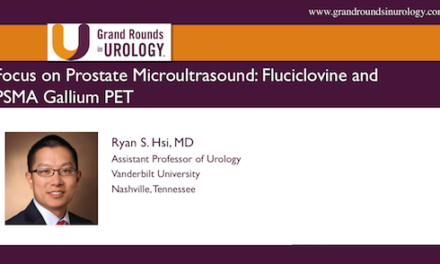E. David Crawford, MD, presented “RADAR 6 & 7 – Detection of Advanced Prostate Cancer Recurrence” during the 33rd International Prostate Cancer Update on January 23, 2023, in Vail, Colorado.
How to cite: Crawford, E. David. “RADAR 6 & 7 – Detection of Advanced Prostate Cancer Recurrence.” January 23, 2023. Accessed Oct 2024. https://grandroundsinurology.com/RADAR 6 & 7/
RADAR 6 & 7 – Detection of Advanced Prostate Cancer Recurrence – Summary
E. David Crawford, MD, Professor of Urology at the University of California, San Diego, and Editor-in-Chief of Grand Rounds in Urology, reflects on the genesis of the Radiographic Assessments for Detection of Advanced Recurrence (RADAR) working group. It originated from a panel debate among faculty during a previous International Prostate Cancer Update meeting. The debate shed light on the folly of automatically ordering bone and computerized tomography (CT) scans for all patients with Gleason 6 prostate cancer undergoing radical prostatectomy, and the pattern of these scans only showing negative results until it is too late. Soon after, a multidisciplinary group met to form RADAR I, which addressed the unmet need for a consensus on eligibility criteria, type of imaging modality, and the frequency of scanning for detecting metastatic disease. RADAR I pinpointed guidelines and recommendations for early identification of prostate cancer metastasis, and also created the three categories of newly-diagnosed patients–biochemically recurrent patients, and M0 castrate-resistant patients–to direct these guidelines. The project continued in RADAR II, which focused on the concept of “therapeutic layering” in metastatic castration-resistant prostate cancer (mCRPC) patients. After a hiatus, the working group reconvened for RADAR III in response to the advent of PET scanning with new agents, namely 18F-Fluciclovine. Among the main objectives of this iteration were to understand the potential use of novel imaging modalities in prostate cancer, the rationale for obtaining these scans, and how easily these novel imaging modalities could be adopted into medical and urologic oncologists’ practices. RADAR III expanded on the category-directed guidelines from RADAR I, adding when it is appropriate to employ next-generation imaging in the evaluation of newly-diagnosed patients, biochemically recurrent patients, M0 castrate-resistant patients, and M1 castrate-resistant patients. Next, RADAR IV sought to define the concept of “transitional disease.” It illustrated the pathway of prostate cancer from rising PSA, biochemical failure after hormone therapy, to transitional disease–a category containing both metastatic castration-sensitive prostate cancer (mCSPC) and non-metastatic castration-resistant prostate cancer (nmCRPC). This publication stressed that the goal of care for patients who reached this last stage should be to prevent them from progressing along the pathway toward mCRPC. RADAR V focused on implementing the topics from RADAR IV, honing in on the essentiality of preventing progression to advanced disease by not hesitating to perform impactful treatments at the transitional disease stage. RADAR VI notably added recommendations for the use of molecular-targeted imaging (MTi). Finally, RADAR VII applies and synthesizes the guidelines from RADAR VI, setting forth an algorithm for guiding treatment decision-making based on MTi.
About The 33rd Annual International Prostate Cancer Update:
The International Prostate Cancer Update (IPCU), founded in 1990, is a multi-day CME conference focused on prostate cancer treatment updates with expert, international faculty. It is led by expert physicians and is designed for urologists, medical oncologists, radiation oncologists, and other healthcare professionals involved in the diagnosis and treatment of prostate cancer. The 33rd iteration of the meeting occurred January 22-25, 2023 in Vail, Colorado. To view more educational presentations from IPCU 33, visit our collection page.
ABOUT THE AUTHOR
Researcher-physician E. David Crawford, MD, Jack A. Vickers Director of Prostate Research and Professor of Urology at the University of California, San Diego, has devoted his career in medicine to educating the public about men's health issues and finding effective techniques and procedures to address prostate cancer, the most common malignancy affecting men in the United States.




